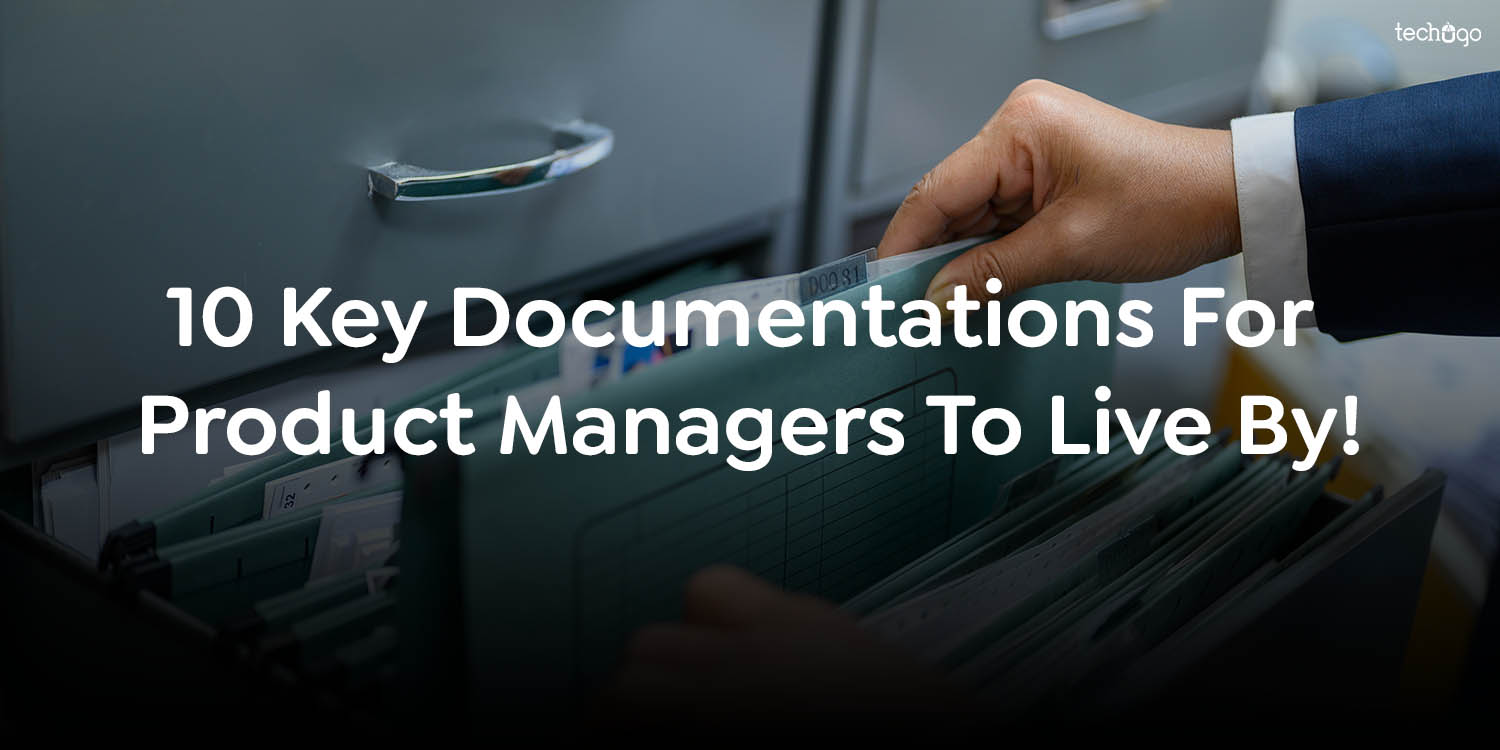The exchange of information plays a crucial role in mobile app development. That is the reason why product managers devote a significant amount of time to enable the same via documentation.
As a top mobile app development company, we understand the long-term goal of documentation management. And with the help of this blog, we will help you learn the benefits of written communication during development and the popular types of documentation.
But first, let’s start with the basics!
What Is Product Management Document?
It is the process of developing, sharing, and managing project documents. Product documentation is anything that plays a role in the product life cycle, from the initial project schedule to project closure.
Product Management documents are the collection of documents that explains almost everything there is to know about a product or piece of software. The goal of product documentation is to enable users to get maximum use and value out of the product in question.
This kind of documentation is essential because it brings all the information about your app, product, or service, into one place. You can focus on everything here, from physical product details, features lists, aesthetic and marketing materials, and approaches to sales and branding.
What Are Advantages of Project Management Document?
It is essential to understand the benefits of a technique before blindly following it. On that note, let us fetch more clarity on the perks of project management documentation.
1. Easy Access To Information
With project documentation, there is no need to go back and forth to retrieve basic information about the product, as the team has no confusion about where the documents are saved.
Since the documents are saved in one place, team members can easily find the information they need. With documentation saved in one location, the development team knows where to find the details they need.
2. Standardized Development Processes
Documentation ensures that no matter how quickly the team grows within a business process, the quality each of them goes through remains consistent.
Standardization is essential for any development process as it plays a crucial role in the alignment of the team. It lets your team operate on the same page, even if you are operating with a mixture of departments.
It triggers the overall efficiency of the team by streamlining the workflow.
3. Reduce Errors
Product documentation helps in version control. It means that one can track and review past the different versions of the same document. With an audit trail, project managers can view the changes made, reducing the chances of error.
Now that you are accustomed to the perks of project documentation, let’s explore the top key practices followed by the managers all around the world.
Major Key Documentations That Project Managers Can’t Ignore!
If your goal is to maximize the productivity of your team and the development, the below-mentioned documentation will surely come in handy.
1. Documentation for competitive analysis
Market research is one of the extensive tasks implemented before initiating the development process. And the first step to it is competitive analysis. This helps the mobile app builders to scrutinize the client’s product competitive scope over the similar ones in the stores.
Here the task majorly consists of investigating the goods and services offered by the existing competition in the market. In addition to that, the research is also focused on evaluating the strengths and weaknesses of the competitors.
Documentation pertaining to competitive analysis consisting of all of the above-mentioned factors is created and shared for the development team’s review. The design can only be finalized by the product manager once they have executed comprehensive research on the competition.
The competitor’s table in the competitive analysis documentation needs to include the following-
- Name of the competitors
- Website address of the competitor
- Number of visitors, users, or app downloads
- Duration for which competitor has been present in the market
- Competitor’s area of expertise
- Revenue generated
- Notes and suggestions
It is important to note that the content for this document may vary from one project to another. Some of the other forms of competitor analysis popular amongst project managers include-
- Capabilities analysis
- Competitive landscape analysis
- Competitive differentiation analysis
- Imitability Ladder analysis
- Value Proposition analysis
2. Documentation for product strategy and vision
Clarity on the vision for any product you are trying to develop helps to build a picture for the future of the same. Vision becomes a way to inspire teams, partners, and investors in the form of a streamlined narrative or a prototype. Managers need to work on an effective product strategy that clears the viewpoint of the product to the audience.
Product strategy and vision, both are required to succeed as a brand. To support the same and to gather all of the information required to figure the output, documentation plays a key role.
Documentation helps to bring the concept to reality. It is then shared with the stakeholders for feedback.
3. Product Requirement Documentation
PRDs collectively highlight different aspects of a product in a single location. Specification documentation is highly popular, and they provide quality control testing, standards, requirements, description of the app’s characteristics, and much more.
PRDs may vary from one another as every single one of them would have its separate specifications. Here’s what these documentation layouts would include-
- Research issue statements
- Success metrics
- MVP feature list
- Technical implementation details
Product requirements documents contain all the necessary steps to build the app. In addition to that, it also contains possible complications or difficulties and the decision to keep or discard a particular set of features.
For product managers, this document is a medium to visualize the following-
- Amount of time necessary for project development processes
- Comprehend the number of resources required for project development processes
- Establish a mutually complete understanding between users and the development team
4. Success Metrics Documentation, KPIs, Objectives & Key Results
Project managers use Objectives and Key Results as a mechanism to decide the goals of product development. Then as the process continues, managers then access the overall outcome.
Where do you wish to go?
Have you arrived or failed?
Above are the two questions answered by the process. The aim helps the team stay focused on the goals, and the outcomes determine if the goal is attained or not.
KPI or Key Performance Indicator determines the current stage of development and is used to measure the overall success of the process. Few KPIs are mentioned below-
- Customer lifetime value
- Trial-to-Customer conversion rate in sales
- Web traffic
- Conversion rate in marketing
These KPIs objectives and their outcomes are listed in the relevant documentation.
5. Roadmaps Documentation
In general, the roadmap of any process helps in communicating the importance of the product to the development teams. Therefore, it is one of the most important documents that managers are required to curate. It is basically a document that lists all the planned initiatives necessary to proficiently build the application or software.
For roadmap documentation, the project managers develop a product life cycle that outlines the following-
- What needs to be done
- When it needs to be done
- How it needs to be done
As the name suggests, roadmap documentation is sort of a route laid by product managers for the entire team to live by. These are distributed amongst the teammates with embedded PowerPoint presentations.
6. Documentation For Design & Prototypes
Building something from ground zero is not like shooting fish in the barrel. Similarly, working on product design from scratch and without a blueprint is difficult. Therefore, project managers need to prepare a document that contains a record of revisions and modifications implemented in the product design.
As far as prototyping is concerned, project managers have a different experience than designers and engineers. They make sure to set a tone for prototyping by sharing clarity about goals and streamlining the roadmap for the team to follow.
One question that might pop up in your mind, why do project managers need to worry about prototype documentation! Let’s answer your question with a set of benefits it delivers-
- All required iterations are completed in a jiffy.
- It is crucial to provide justification for the notions during the initial stages of the product development.
- The potential for misunderstanding is completely eliminated.
- Prototype documentation enables improvements in the quality of technical feedback.
7. Consumer Journey & User Narrative Documentation
User stories and consumer journeys are two critical tools used during the development of any product. Therefore, product managers maintain the documentation for these two positions to ensure that all the necessary details are recorded and kept safe and secure.
For a user narrative document, managers need to think about several reasons why a user would want to utilize the product that is being developed. They need to evaluate the development on a microscopic level to understand the user narrative. This would require project managers to record everything that might lead up to users interacting with the platform’s features, bugs, requests, and much more.
On the other hand, the consumer journey highlights the complete user experience. Starting from the point of download to product’s feature usage, a consumer journey document would map the entire experience. It proves extremely helpful in situations where product managers need to explain & establish confidence in the product in front of the stakeholders and their development team. In addition to this, the document can be helpful for running ad campaigns or illustrating the use case of a product to its target audience.
8. Release Notes & Scope Documentation
Release notes are the documents that are shared with the release of the new SaaS product or app platform. Since the SaaS products differ from each other, no two documents are the same. Product documentation for release notes is prepared because of the following reasons-
- Inform the users about the new standards
- Discover the issues that have been resolved
- Market the app after the completion of the update
Managers use scope documentation as a tool to define the features that the product would contain. Some groups also refer to it as the scope of work documents, and it highlights characteristics of the features.
9. Guides And Frequently Asked Questions
Delivering internal and confidential guides and FAQs to the stakeholders is required to keep information flowing through the complete development process. The FAQs are written in simple language and need to be to the point. In addition to this, it also consists of a wireframe of the product along with a strong UX component.
Through this documentation, project managers can ensure that the information is being recorded in a way that simplifies the hand-offs within the team.
These are internal manuals that have complete information about the functioning of the development process. These also act as references for different departments like marketing, sales, and customer support to deliver an improved experience to the target audience.
10. User Manual Documentation
Also known as consumer-facing product documentation, these are the responsibility of product managers. It’s one of the most used & developed documents which covers information for the target audience on how to use the product.
A newly launched product in the market without a proper user manual may leave a huge gap between the consumers and the business. This documentation will help the consumer to get started and become accustomed to the product until they get used to it.
Product Document Management: Optimization & Best Practices
Having reviewed the perks and the popular types of documentation, you might be wondering how to put the information into action.
Let me share some of the popular tips to follow the same!
1. Plan your documentation
Through planning, you would be able to build a solid foundation right from the beginning. It plays a key role in establishing the direction and management you need to stay on top of your documentation game.
Not to mention that planning your documentation presents you with an opportunity to share the details with your team before it goes live.
For planning the product document management, you may use work management software. It will help you to create a robust and flexible document plan.
2. Share processes with the team
After finalizing the product document plan, you must share the details with your development team. It promotes transparency and keeps everyone up to the speed of the latest development.
Try to use shared inbox tools to ensure that the team is aligned with the plan.
3. Archive what’s not important
You don’t need to delete the documents that are no longer up-to-date or required, as you can simply archive them.
Information in the documents could turn valuable in the future for new team members. But you don’t need to keep them at the forefront of your documentation. Archiving lets you store out-of-date documents and makes it easy for your team to navigate through the pool of information.
Wrapping It Up!
A lot of times, being a product manager is more than organizing, planning, and executing. It’s clearly not an easy feat as it has several layers to it. From creative to technical, there are multiple verticals managers need to focus on.
There are times when project managers need to get into the shoes of the consumer to develop a mindset that would allow the product to come to life. Whether it is collaborating with the development team or streamlining the product for the target audience, managers have a lot on their plate. Documentation, therefore, plays a huge role in simplifying their tasks.
Once you develop an understanding of the above-mentioned documents and start integrating them, you will be able to contribute to the success of the product through an effective management process.
That is all for now. If you have any more doubts, feel free to connect with us for more information.
Until then, stay tuned for more tech insights!
Post Views: 3,859




 SA
SA
 KW
KW
 IE
IE AU
AU UAE
UAE UK
UK USA
USA
 CA
CA DE
DE
 QA
QA ZA
ZA
 BH
BH NL
NL
 MU
MU FR
FR

























